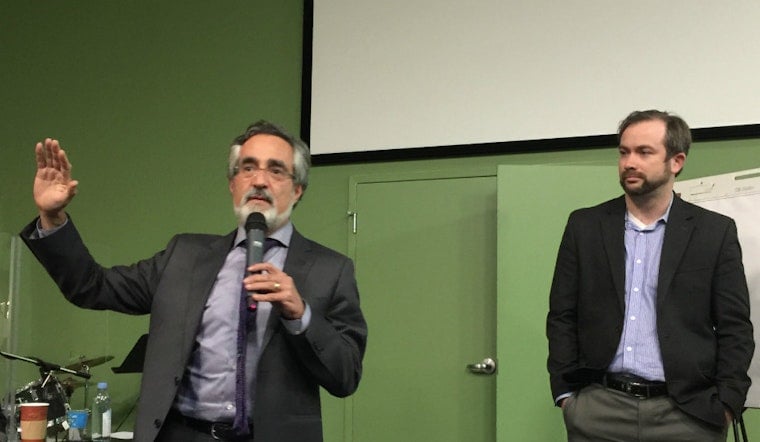
On Thursday night, the SF Planning Department held a presentation on the Affordable Housing Bonus Program for residents of District 3. The event drew a standing-room-only crowd to St. Paulus Lutheran Church (1541 Polk St.) Planning has been hosting similar meetings across the city this month, from the Sunset to Alamo Square.
The proposed legislation would reward developers for creating more affordable housing than is currently required by law. Under it, new housing built on eligible sites could add up to two additional stories above current height limits—as long as 30 percent of the new units are permanently set aside for middle- or low-income residents. If 100 percent of the building is affordable, three stories can be added above height limits. Planning has further details on its website, along with a list of upcoming meetings in other districts.

Red line = existing height limit. Blue line: with AHBP bonus. (Graphic: SF Planning)
Some components of the program have remained unclear, and at the meeting and in online discussions, D3 residents raised a litany of concerns. Many were concerned the program will allow developers to demolish current rent-controlled housing, while some argued that allowing increased height limits will destroy neighborhood character. Others expressed concerns about small businesses being displaced if a building is torn down. (A recent Hoodline article, as well as the Coalition for San Francisco Neighborhoods' (CSFN) website, outline these concerns in more detail.)
The CSFN and Telegraph Hill Dwellers arrived early to last Thursday's meeting, placing flyers on all of the chairs that outlined their concerns about the program. (Paul Webber, a member of the Telegraph Hill Dwellers Executive Committee and Coalition for San Francisco Neighborhoods, also spoke at the Jan. 14th meeting of the Haight Ashbury Neighborhood Council. )
"So why are we doing this?" said Gil Kelley, director of citywide planning, at the D3 meeting. "It’s really proposed principally as embodying a local alternative to the state-mandated density bonus.” The 1979 state law already permits developers to go two stories above local height limits if they set aside 13-20 percent of the units for very low-, low- and moderate-income individuals.
"What’s driving this proposal and many of the housing discussions is the affordable housing crisis," Kelley continued. "San Francisco continues to grow, continues to be an attractive place to live."
He noted that the city has added about 10,000 people each year for the past five years, and that should hold true for the next 15 years. That means a net addition of 140,000–150,000 people by 2030. Each year, 60,000 residents move out, while 70,000 move in. "People with lesser incomes and families are moving out," he said.

San Francisco's proposed ABHP. (Graphic: Planning Commission)

The state's AHBP. (Graphic: Planning Commission)
"This program, as it's constructed, is designed to provide middle-income housing at a scale we’ve never achieved in the recent history of the city and county of San Francisco," said Jeff Buckley, the mayor's housing policy advisor. He recognized that people in the community have concerns, but reiterated that the city's program is in response to a court decision in Napa concerning the state law. More information on that is in a Planning memo on AHBP.
But District 3 Supervisor Aaron Peskin said he "parts company" with Planning on their assessment of the city's need to react to the state case. "I don’t think we are under any imperative by virtue of decision in the Napa County case to act or act quickly," he said. "Napa got sued because they were not building affordable housing. In the city and county, we are building affordable housing. No one’s suing us; it’s not a case that applies to us."
That's also an argument being used by those supporting the AHBP. Fay Darwami Darmawi, a North Beach resident, said opponents’ concerns that a new city law would be an incentive for developers to Ellis Act more buildings is a red herring.
“People are saying that developers would use it to demolish rent control buildings to build bigger and higher,” she said. “It’s not going to happen in D3. The city ordinance, as proposed, is much more onerous than the state law. And no one has used the state law, so how would a more onerous ordinance be more incentive? It isn’t.”
“It’s only going to be marginally effective now, when the market’s hot," Darmawi continued. "When the market goes south, the extra added burden of affordable housing is going to make the developers not do anything, actually.”
Another community meeting on Jan. 12th at the County Fair Building in Golden Gate Park featured an outcry about rent-controlled units possibly being lost, after questions about the matter. There, Planning announced no buildings with rent control would be eligible for the program. But the veracity of that statement continues to be questioned.
 The Planning map that shows the maximum possible areas that could be rezoned. Purple = neighborhood commercial corridor, yellow gradients = large family homes are lightest, to high-density as darkest — check out the interactive map to explore all the nuances. (Image: via SF Planning)
The Planning map that shows the maximum possible areas that could be rezoned. Purple = neighborhood commercial corridor, yellow gradients = large family homes are lightest, to high-density as darkest — check out the interactive map to explore all the nuances. (Image: via SF Planning)
We asked Kearstin Dischinger, the main presenter at the D3 meeting, to clarify the rules via email. “Projects that have had rent control units in the proceeding three years cannot participate in the program," she responded. She also said the program would protect rent-controlled units “in perpetuity,” noting it would take additional legislation—approval from the Capital Planning Committee, Board of Supervisors and mayor—to change that.
The source of the confusion, Dischinger said, was her statement in one meeting that rent-controlled buildings would be protected for one year. What she actually meant, she said, was that “we'd study for one year and then come back with a proposal ... That comment has been very misunderstood, so it is simpler to just say in perpetuity.”
The map Planning circulated still shows 30,000 buildings citywide, a number that seems high with rent-controlled properties off the table. In response to our questions, Kelley explained that the city doesn’t have accurate data to identify which buildings are or are not rent-controlled. Kelley said it will be a “two-step process”—if someone applies, the city will first determine whether the property is eligible.
That didn’t set well with Stan Hayes, president of Telegraph Hill Dwellers, who said his group is concerned about “regulatory overreach.” His understanding from Planning is that only about 240 buildings citywide could truly take advantage of the program.
“To us, a more focused approach to this would be preferable," Hayes said. "It’s a one-size-fits-all approach that doesn’t take into account the individual circumstances of each property. A program tailored to the unique qualities of each site would protect the character of the neighborhood.”
Another concern specific to D3 is the prospect of adding more residents to an already packed area of the city. Peskin said his district is already the densest in terms of population. "Of the 11 supervisorial districts, it’s geographically the smallest, but it has the same population.... There are parts of the city where houses don’t touch,” he said, to a round of laughter. He said he believes in "density equity.... we have an obligation to maintain the neighborhood fabric.”
According to a slide shown at the meeting, North Beach could see 4 percent more housing units under the AHBP program, while the FiDi could get an additional 11 percent. The only areas equal to or greater than the potential increase in the FiDi are the Western Addition, at 11 percent, and Bayview, at 23 percent.

Projected increase in AHBP units, by neighborhood. (Map: SF Planning)
Peskin also asked Planning if Port of San Francisco properties would be eligible for the AHBP, given the June 2014 passage of Proposition B, which requires city voters to approve any increase in height limits on those parcels. The ballot measure grew out of opposition to the proposed development at 8 Washington, and the State Lands Commission later brought a lawsuit against the city regarding Proposition B that’s still in the courts.
“I think the right thing to do is take all of the seawall lots out of the program. I find it a little troubling that you guys would have those on there,” Peskin said at the meeting. Dischinger later confirmed that Port properties will not be part of the program area.
THD's Hayes said his organization is also concerned that the program won’t allow the Planning Commission to deny a project if it’s not a good fit for the neighborhood. Dischinger's response: “I don’t think there’s anything in there than limits the [Planning] Commission.” Kelley added there still is some ability to shape projects.
For her part, Darmawi isn’t concerned about changing neighborhood character, telling us that allowing two or three more floors will “make San Francisco look more like Paris ... 2.2 million people live in Paris, which is about twice as big as San Francisco, with four times as many people. Paris is a city of five- and six–floor buildings. San Francisco is a city of three- and four-story buildings.” She said D3 does have surface lots and other parcels that could be readily developed under proposed AHBP laws, with no negative effect on the community.
The sheet the CSFN distributed also raised the issue of “promot[ing] density while ignoring our already overcrowded transit infrastructure.” Kelley responded at the meeting by noting that developers’ impact fees and ongoing property taxes would pay for increased transit.
Both the CSFN and THD, among others citywide, are concerned about the displacement of small businesses, because commercial space isn’t protected by rent control. Planning said the Office of Economic and Workforce Development will work with them through the city's Invest in Neighborhoods program.
Several other issues were raised throughout the two-and-a-half hour meeting, from side and rear yard requirements to allowing light into alleyways to historic preservation issues to whether or not the AHBP would allow micro-units (Planning says no). Kelley reiterated that the program is a proposal at this point, and changes can still be made, including more community meetings. “I’m sure the program will be modified and tweaked as it goes forward," he said.
After neighborhood meetings wrap up, the Planning Commission will hold a hearing on the AHBP at its regular meeting, which starts at noon on Jan. 28th in Room 400 of City Hall. Should it move forward, it will then go before the Board of Supervisors' Land Use and Economic Development Committee, and eventually, the full board.









